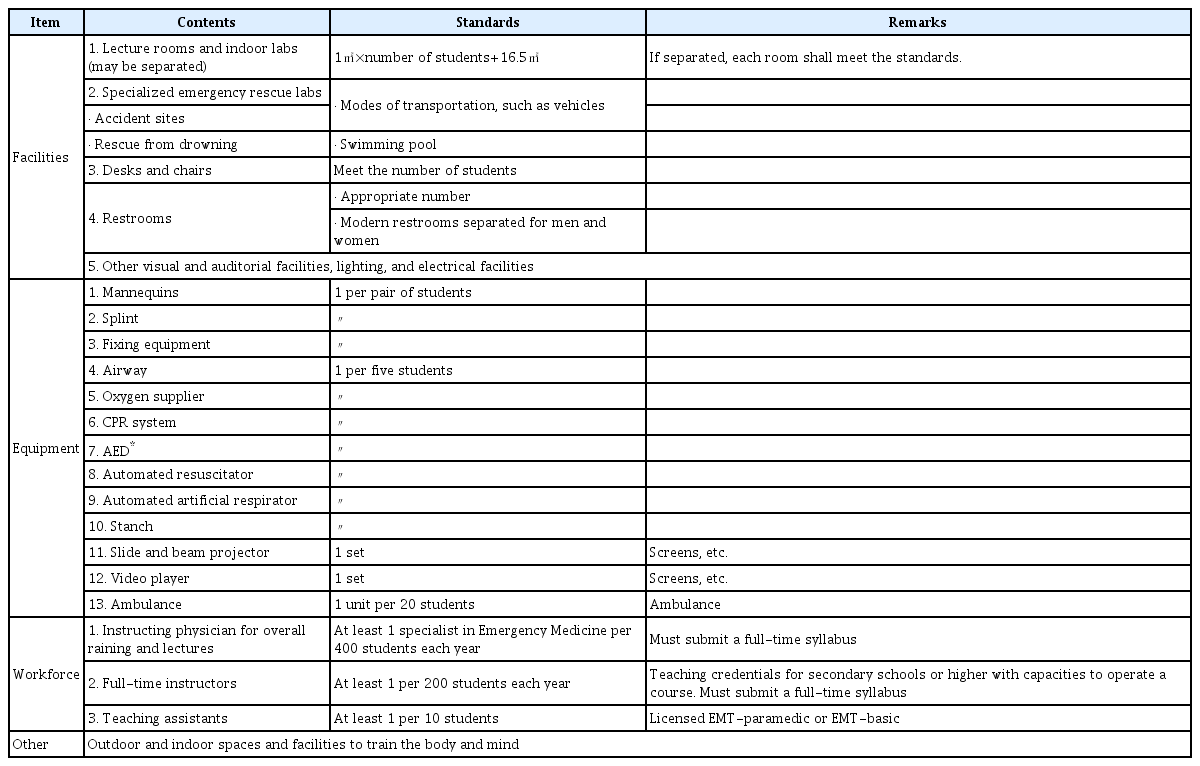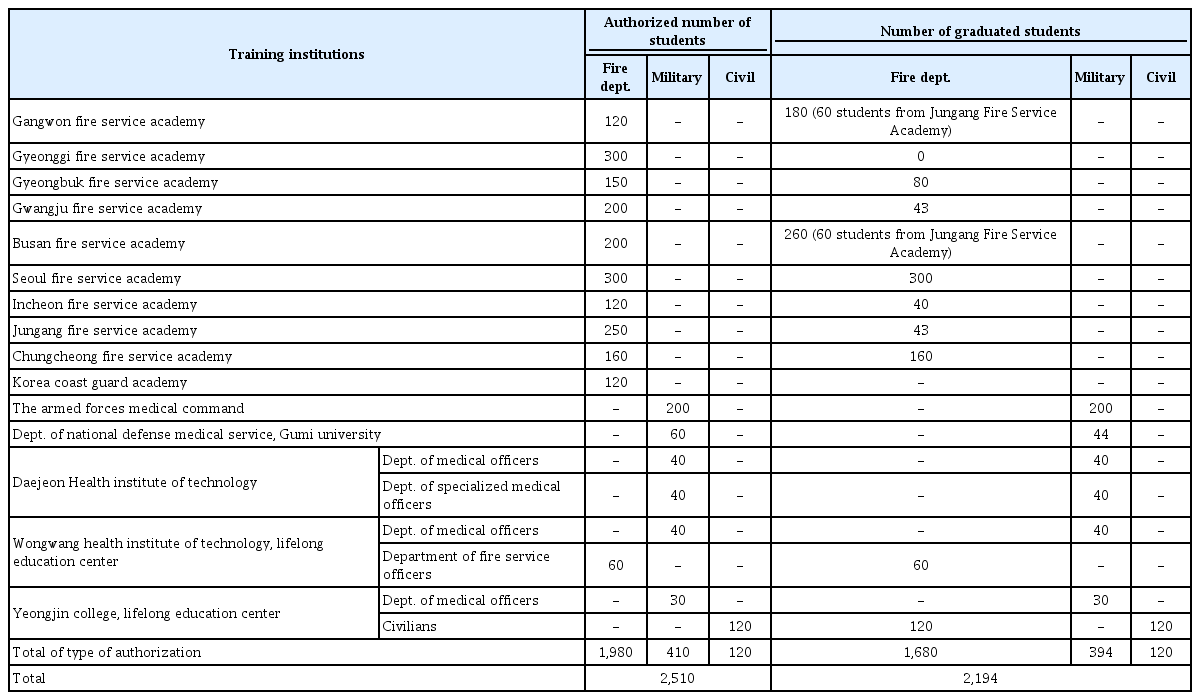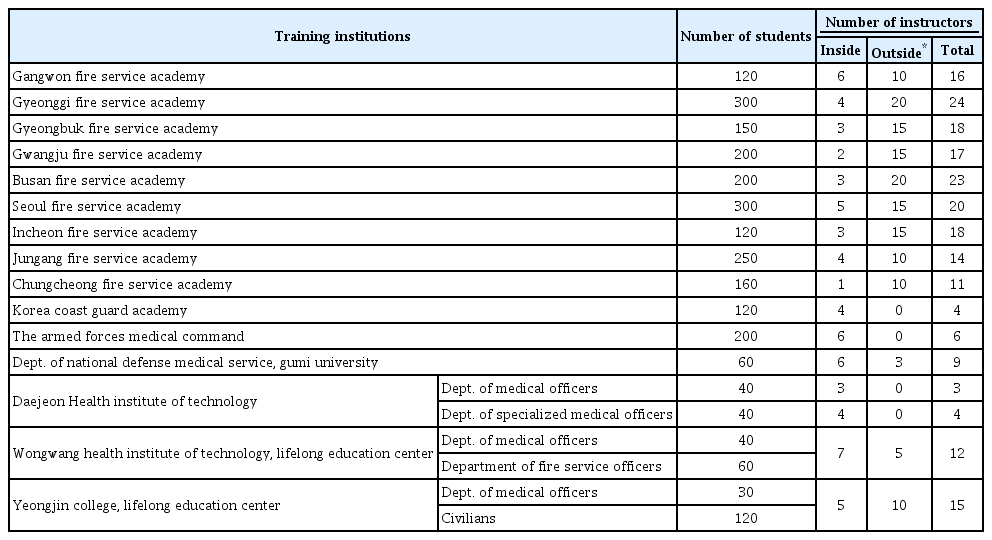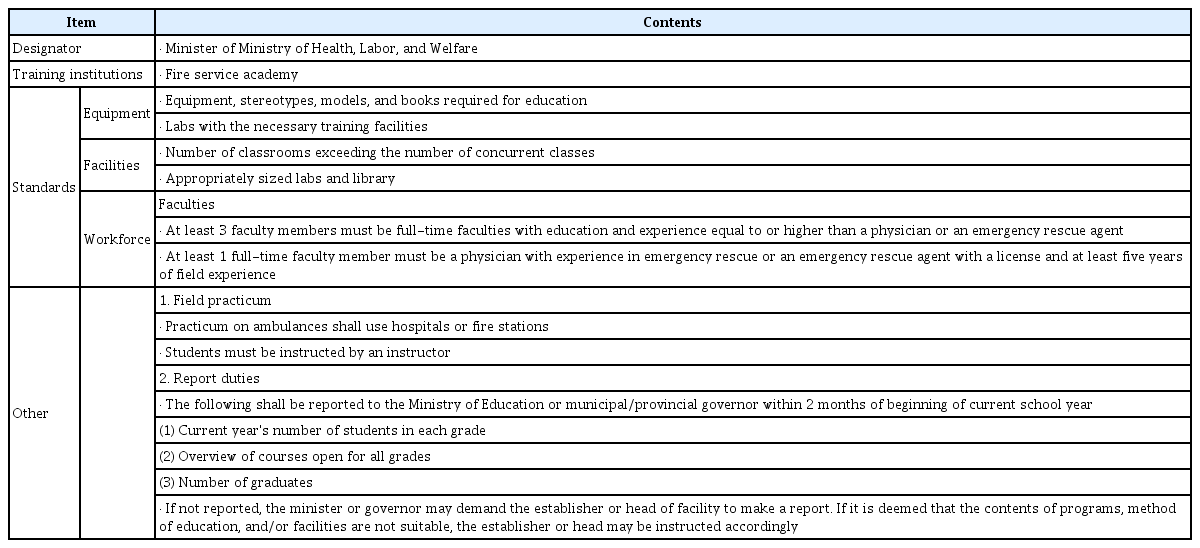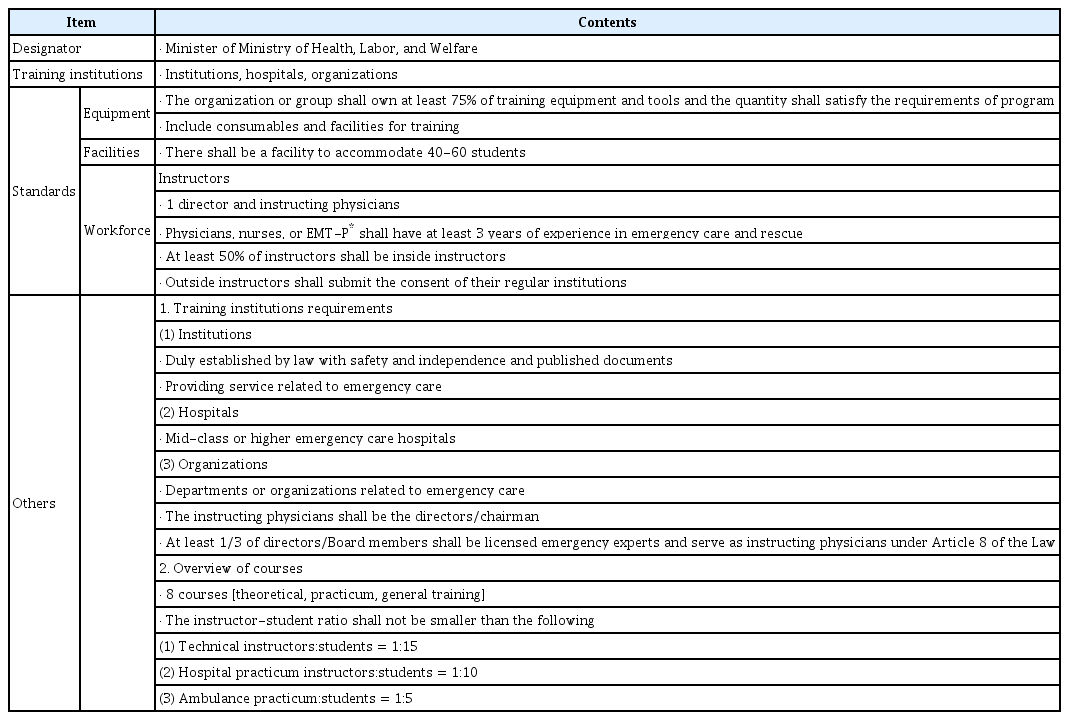2급 응급구조사 양성과정 개선방안 연구 : 양성기관 현황 및 지정기준 검토
Improvement in emergency medical technician-basic training program : a review of the status of training institutions and designation criteria
Article information
Trans Abstract
Purpose
To discuss the records and legal standards of emergency medical technician training institutions in Korea and abroad, to identify the problems, and to provide the basic resources for improving the EMT-basic training institutions.
Methods
We received advice through an advisory meeting of experts (professors of department of emergency medical technicians) and interested parties (Korean Association of Emergency Medical Technicians, officials of emergency medical technician training institutions) and referred to various reports published by governments, official institutions, and other trustworthy organizations. Also, we communicated with the related experts abroad (3 countries) on the phone or by email for surveys.
Results
Compared to the abroad, it is necessary to categorize the standards and procedures of designating the emergency medical technician training institutions in Korea and improve the management of training institutions to train competent emergency medical technicians.
Conclusion
It is necessary to designate and manage continuously the emergency medical technician-basic training programs for the systematic primary healthcare service.
Ⅰ. 서 론
1. 연구의 필요성
1993년 아시아나 항공기 추락사고, 서해훼리호 침몰사고, 영동 고속도로 버스 추락사고는 병원 전 중증도 분류가 이루어지지 않았을 뿐만 아니라 처음 구조인력은 모두 민간단체였기 때문에 체계적인 구조 및 응급처치 등이 이루어지지 않아 병원 전 단계의 전문 인력의 필요성을 보여주고 있다[1]. 이후 1994년 성수대교붕괴, 충주호 유람선 화재와 1995년 대구 지하철 가스폭발, 삼풍백화점 붕괴사고는 응급의료체계 구축 시작단계에서 매우 큰 재난으로 보고되었다.
이러한 재난이 있고 난 뒤 병원 전 응급의료 전문인력 및 응급의료시스템의 구축이 필요하였고 이를 효율적으로 운영하기 위해 인력 측면에서 응급구조사의 필요성이 대두되었다. 이에 1994년에 응급의료에 관한 법률을 제정하고 1995년에 응급구조사 국가고시가 시작되었으며, 1급 응급구조사 양성을 위한 전국 11개 대학에 응급구조(학)과가 개설되었다.
응급의료체계에서 병원 밖 응급의료는 주로 응급구조사가 담당한다[2]. 응급구조사는 응급환자가 발생한 현장에서 응급환자에 대하여 상담, 구조, 및 이송의 업무를 행하며 정해진 업무 범위에서 현장에 있거나, 이송 중이거나 의료기관 안에서 응급처치의 업무에 종사할 수 있다. 특히 응급상황에서 가장 먼저 사고 현장에 도착하고 응급처치를 수행하는 등 응급환자에게 도움을 줄 수 있는 전문 인력이다[3].
응급구조사는 업무 범위에 따라 1급과 2급으로 구분되며 1급 응급구조사는 응급구조학 전공이 개설된 대학에서 고등교육과정의 이수를 거쳐 자격이 주어지고, 2급 응급구조사는 보건복지부에서 지정한 양성기관에서 교육을 이수하게 된다. 이때 2급 응급구조사 양성기관으로의 지정을 위해는 응급의료에 법률에서 정하고 있는 인력과 시설을 갖추어야 하며, 구급차 동승 실습 50시간과 응급의료기관 실습 50시간을 포함한 일정 교육 시간 등의 기준을 준수하여야 한다[4].
2급 응급구조사는 1995년에 국립의료원, 대구영진전문대학, 광주보건전문대학, 서울소방학교, 중앙소방학교 등에서 3개월의 양성과정으로 147명을 배출을 시작으로 현재는 9개의 소방학교, 해양경찰교육원 및 국군 군의학교가 있고 각 기관의 공공 응급의료 수요에 따라 교육과정을 진행하고 있다. 그 외에 대전보건대학, 영진전문대학, 원광보건대학, 구미대학 등에서 군과 관련된 의무부사관학과가 양성기관으로 지정되어 교육과정을 운영하고 있고, 영진전문대학 평생교육원에서 일반인을 대상으로 교육이 이루어지고 있다[5-7].
(사)대한응급구조사협회 통계자료에 의하면 1995년부터 2018년까지 응급구조사는 총 37,988명으로 이 중 1급 응급구조사가 18,986명이며 2급 응급구조사는 19,002명으로 2급 응급구조사가 조금 더 많이 배출되었다[8].
Choi 등[5]의 선행연구에서는 응급구조사의 질적 문제가 제기되었고, 해결방안으로 교육과정 표준화, 2급 응급구조사 양성기관 관리 및 감독, 교육 인증평가제도 도입 등 응급의료체계의 핵심인력인 응급구조사 인력양성 및 배출 방안을 제안하고 있다.
2007년 보건복지부 연구 결과 보고서인 응급구조사 양성대학 및 양성기관의 교육과정 평가방안 개발에서는 2급 응급구조사 양성기관의 교육과목 및 시간, 양성기관 지정의 시설, 장비, 인력 기준 등의 부적절성을 지적하고 있으며[9], Yuk[10]의 선행연구에서도 2급 응급구조사 양성기관의 지정기준은 응급의료를 제공하기에 지식 및 수행 수준이 비교적 낮은 편으로 이를 향상하기 위한 법 제정, 표준화된 교육 관리, 양성기관의 질 관리를 높일 방법 등을 요구하고 있다.
2. 연구의 목적
국내외 2급 응급구조사 양성기관 현황을 살펴보고 재검토하여 문제점을 파악하고, 이를 기초로 2급 응급구조사의 내실 있는 양성관리방안을 제시하고자 한다. 또한 2급 응급구조사 양성기관 재지정 및 신규지정을 검토하는데 참고자료로 활용될 수 있게 하고자 한다.
3. 자료 수집 및 제한점
본 연구에서 우리나라의 2급 양성기관의 현황을 파악하기 위한 자료는 보건복지부에서 제공한 자료와 양성기관의 홈페이지에 기재된 자료, 그리고 양성기관에 직접 설문과 면담을 통해 파악한 자료를 활용하였다. 미국, 일본 및 대만의 국외 현황은 각국 정부나 공공기관에서 발행한 신뢰할 수 있는 보고서, 양성기관의 홈페이지에 기재된 자료 및 논문을 참고하였다.
국내 양성기관의 설문을 통해 파악한 자료 중에서 전임강사 자격 사항은 일부 자료가 누락되거나 밝히지 않은 부분들이 있어 구체적인 현황 분석이 미흡한 점이 있음을 밝힌다.
Ⅱ. 연구방법
1. 국내외 2급 응급구조사 양성기관 및 지정기준 현황
1) 국내 양성기관 현황
(1) 양성기관 지정 절차 및 기준
2급 응급구조사 양성기관으로의 운영을 위해서는 보건복지부에 지정신청을 해야 한다. 이후 시설기준 실사를 통해 지정 여부가 결정된다. 또한 지정받은 양성기관은 규정된 지정기준[응급의료에 관한 법률 시행규칙 제24조 별표10]<Table 1>에 규정된 지정기준을 상시 유지하고 교육과목 및 시간을 준수하여야 하며, 지정권자인 보건복지부 장관은 지정기준 등 미비 시 사안에 따라 지정취소가 가능하다.
(2) 양성기관별 인가 정원 및 배출 인원
보건복지부의 자료에 따르면, 2018년 8월 기준으로 국내에 15곳의 2급 응급구조사 양성기관이 지정되어 있고, 양성기관을 소방, 의무부사관 학교를 포함한 군 그리고 민간기관으로 구분하여 인가받은 정원과 실제 교육과정을 운영하고 배출한 인원을 분석한 결과는 <Table 2>과 같다. 2018년 기준 2018년 총 인가 정원은 2,510명이었고 이 중 87.4%인 2,194명이 실제 양성되었다. 기관 유형별로는 소방의 경우 정원은 1,980명이며 실제 양성된 인원은 1,680명으로 84.8%에 해당하였고, 군의 경우 410명 중 394명(96.0%), 민간은 120명 정원에 120명을 모두 양성하였다.
(3) 양성기관별 강사진 현황
양성기관별 강사진에 대한 현황은 각 기관에 협조 요청을 통해 조사되었다. 소방학교의 경우 외부 강사진 인원은 기수별로 유동적이기 때문에 평균 인원으로 기재하였고, 각 기관에서 응답한 내용 그대로 작성하였다. 9개의 소방학교는 평균 17.8명의 강사가 있으며, 해양경찰교육원은 4명의 내부강사, 국군의무학교는 6명의 내부 강사, 구미대학 국방의료과는 9명의 강사, 대전보건대학 의무부사관과 3명, 특전의무부사관과 4명, 원광보건대학은 7명의 내부 강사와 5명의 외부 강사, 영진전문대학 평생교육원에는 5명의 내부 강사와 10명의 외부 강사가 있다<Table 3>. 모든 기관의 외부 강사는 응급의학과 의사나 응급구조학과 교수들로 구성되었으나, 전임강사(내부 강사)의 경우에는 구체적인 자격 또는 면허여부를 확인할 수는 없었다.
양성기관 지정기준에서 제시한 인력 기준인 학생 200명당 전임교원 1명은 모두 충족하는 것으로 나타났다. 다만, 조교의 기준이 교육생 10명당 1인 이상으로 되어 있어 1회 교육을 할 때 몇 명을 대상으로 실시하느냐에 따라 달라질 수 있겠지만, 내부 강사만으로 충족되기가 어려울 것으로 보이며, 또한 외부 강사인 응급의학과 의사나 응급구조학과 교수들이 조교를 담당하지는 않으리라고 보여 구체적인 실사가 이루어져야 할 것이다.
2) 국외(미국, 일본, 대만)의 양성기관
(1) 미국
미국의 응급구조사 양성기관은 연방정부에서 지정하며, 승인된 교육기관, 공공 안전기관, 의료기관 등에서 양성이 이루어지고 있다. 장비에 대한 기준은 기본 교육 지원 장비 및 교육을 보조하기 위한 청각, 시각, 활동적인 장비 제공으로 세부적으로 명시하고 있지 않다. 시설 기준은 학생들의 수업 참여를 위한 기준 및 교육 자재를 보관하기 위한 창고 공간의 기준이 정해져 있으며, 양성기관의 인력 기준으로는 학과장의 자격 사항 6가지, 강사의 자격 사항 6가지를 세부적으로 명시하고 있다<Table 4>[11-13].
(2) 일본
일본은 우리나라 1급 응급구조사에 해당하는 구급 구명사만이 있고 2급 응급구조사는 없다. 다만, 후생성 장관(우리나라의 보건복지부 장관)이 지정하여 소방에서 소방공무원에게 병원 전 구급활동을 위하여 구급대원 양성코스를 운영하고 있다. 양성기관의 장비에 대한 기준은 교육에 필요한 기자재, 표본, 모형 및 도서를 보유하고 실습에 필요한 실습 설비를 갖추고 있어야 한다. 시설기준으로는 수업을 받는 학생의 수를 초과하는 전용 교실을 보유해야 하며, 적절한 크기의 전용 실습실과 강의실을 보유해야 한다. 인력 기준으로는 교원 중 3명 이상은 의사, 구급 구명사 또는 동등 이상의 학식과 경험을 갖는 전임교원이 있어야 하며, 전임교원 중 한 사람 이상은 구급 구명 처치에 관해 경험이 있는 의사 또는 면허를 취득하고 5년 이상 업무에 종사한 구급 구명사로 명시하고 있다<Table 5>[14-17].
(3) 대만
대만은 후생성 장관의 지정을 받은 기관, 병원, 단체에서 응급구조사 양성이 이루어지고 있다. 양성기관의 장비에 대한 기준은 적절한 소모품 및 운영과정을 충족할 수 있는 훈련 장비를 보유하고 있어야 한다. 교육 시설은 40명에서 60명까지 수용할 수 있는 교육 장소를 갖추고 있어야 하며 인력 기준 중 강사의 기준으로는 교육과정의 총 책임자 1명, 의료지도 의사가 있어야 하며 3년 이상 응급의료 및 구급활동에 종사한 의사 또는 파라메딕으로 명시되어 있다. 또한 내부 강사가 모든 강사 숫자의 50% 이상을 차지하고 있어야 한다<Table 6>[18, 19].
2. 2급 응급구조사 양성기관 개선점
1) 지정 절차 및 관리의 개선
국내 2급 응급구조사 양성기관의 지정에 있어서 지정기준은 응급의료에 관한 법률 시행규칙에 명시되어 있지만, 재지정이나 취소에 관해서는 법령에 명시되어 있지 않고 규정도 없는 실정이다. 양성기관의 체계적인 관리를 통해 질 높은 교육과정을 제공하도록 하고 우수한 인력들을 배출시키기 위해서 다음과 같은 관리방안을 제안한다.
첫째, 양성기관 지정과 관련하여 현지 실사는 전문가로 구성된 위원회를 구성하고, 보건복지부로부터 위탁받은 기관이나 공인된 단체(예, 대한응급구조사협회) 등이 실시할 수 있도록 하여야 할 것이다.
둘째, 지정 절차는 다음과 같다.
2급 응급구조사 양성기관의 지정을 위해서는 보건복지부의 지정 공모 → 희망 기관의 지정 신청서 제출 → 신청서 검토 및 예비 선정 기관 통보 → 현지 실사를 위한 심사위원회 구성 → 현지 실사를 위한 증빙서류 제출 → 현지 실사 → 지정교육기관 선정 및 통보 → 지정서 교부 순으로 진행을 제안한다.
셋째, 지정기관 취소 등 행정처분 기준마련이다.
입소자나 이용자에 대한 학대, 교육 이수 관련 서류의 허위 작성 등 중대한 위반행위로 인하여 시설 또는 2급 응급구조사 양성기관의 정상적인 운영이 불가능하다고 인정되는 경우에는 개별기준에도 불구하고 제1차 위반 시 사업의 폐지 또는 지정의 취소를 명할 수 있어야 한다. 지정기준 중시설기준, 학습 교구 기준, 직원 배치기준을 위반한 경우에는 경고 및 시정명령을 내리고, 이를 3차 위반 시 지정 취소를 명할 수 있어야 한다. 또한, 양성기관이 정당한 이유 없이 보건복지부가 요구한 보고 또는 자료 제출을 하지 아니하거나 거짓으로 한때 또는 조사·검사를 거부·방해하거나 기피한 때에도 경고 및 시정명령을 내리고, 3차 위반 시 지정취소를 명할 수 있어야 한다. 정원을 지정받고 교육과정을 1년 이상 운영하지 아니한 경우에도 지정 취소를 해야 한다.
2) 강사 기준에 대한 개선
국외(미국, 일본, 대만)의 강사 기준은 응급구조학 전공 또는 의사 등 응급의료와 관련한 실질적인 경험이 있는 사람으로 한정하고 있다. 반면에 한국은 전임강사의 경우 중등학교 이상 교사 자격증 소지자로서 양성 교육에 전담할 수 있는 자라고 되어 있고, 응급구조학 관련 전문성과 실무 경험 여부의 기준을 제시하고 있지는 않다[20]. 따라서 우리나라도 2급 응급구조사 양성기관 전임강사 인력 기준을 현재 중등학교 이상 교사 자격증 소지자 조건 대신 응급구조학 관련전공 석사 학위 이상 소지하고 현장경험 혹은 해당 분야 교육경력이 있는 자 등으로 세부분화하여 명시해야 할 것이다.
3) 시설 및 장비 기준에 대한 개선
국외 시설 및 장비 기준안 보면 미국은 기본 교육 지원 자재 제공, 교육을 보조하기 위한 청각, 시각 및 활동적 장비를 제공한다. 일본은 교육에 필요한 기자재, 표본, 모형 및 도서를 보유할 것, 실습실은 실습용 설비에 필요한 것들을 보유할 것으로 되어있다. 대만은 조직 또는 그룹은 훈련 장비 및 기구의 최소 75%를 보유해야 하며, 그 수량은 운영과정의 요구 사항을 충족해야 한다[19]. 또한 ‘과정 교육을 위한 적절한 소모품 및 시설을 제공하여야 한다’라고 규정하고 있고 3개국 모두 구체적으로 명시하지는 않았다. 국내 장비 기준 중 한 예로 부목에는 여러 가지가 있음에도 불구하고 단순히 부목이라고만 명시되어있는데 실제 현장에서 많이 사용되는 부목들을 정확히 기재하여 기준을 세우는 것이 필요하다. 즉, 용도별 세세하게 부목을 분류하고 교육 인원별 최소 수량을 정하는 것이 필요하다. 마네킹의 경우에도 수량의 기준만 있을 뿐 정확한 마네킹의 종류(예: 성인, 소아, 영아)에 대한 기준이 명시되어 있지 않다. 또한 자동심폐소생기의 경우는 현장에서의 활용도가 현저히 낮은 수준임을 고려할 때 여러 양성기관의 의견에 따라 최소한의 장비 보유 기준의 완화가 필요하며, 장비의 필요성에 대한 재검토가 요구되는 등 학생들의 활용도와 현장 사용 빈도에 따라 장비 목록이 구분돼야 할 것으로 판단된다. 시설 기준에서는 수영장과 같은 시설은 외부 시설을 위탁하여 이용할 수 있음으로 기준 완화가 필요하며, 구급차 보유기준 역시 교육생 수가 아닌 양성기관별 1대 혹은 구급차 모형의 실습공간으로 완화할 필요가 있다.
Ⅲ. 결론 및 제언
1. 결론
우리나라가 2급 응급구조사를 양성한 지 25여년이 지났음에도 불구하고 양성기관들에 대한 검토와 교육의 질적 제고를 위한 노력은 미흡하다. 본 연구는 우리나라 2급 응급구조사 양성 현황을 파악하고 국외 상황과 비교하여 양성기관의 체계적 관리를 위한 방안을 제시하고자 한다.
2급 응급구조사 양성기관의 지정기준은 응급의료에 관한 법률 시행규칙에 규정되어 있지만, 재지정이나 취소, 관리 감독에 관한 자세한 규정은 명시되어 있지 않아 지정취소를 위한 구체적인 기준이 법 또는 규정으로 제정되어야 할 것이다. 전임강사 기준의 경우 미국, 일본, 대만 등의 나라에서 응급의학이나 응급구조사와 같은 자격과 실무경력을 명시하고 있어 전문성을 강조하고 있지만 우리나라는 그렇지 않아 국내의 강사기준안도 응급구조학 관련 전공 석사 학위 이상 혹은 관련 분야의 실무경력, 해당 분야의 교육경력 등으로 세부적으로 명시해야 할 것이다. 장비 기준안의 경우는 우리나라가 장비명을 구체적으로 명시하고 있으나 시대의 흐름에 따라 현장에서의 활용도가 현저히 낮은 장비들도 포함하고 있어, 장비 기준을 포괄적으로 정하거나 주기적인 재검토를 통해 새로운 장비의 지정이 필요하다. 시설 기준에 있어서 수영장의 경우 교육생들의 활용도를 고려하였을 때 자체적인 운영보다 외부 시설에 위탁도 가능하도록 하는 것이 더 효율적일 것이다.
2. 제언
첫째, 응급구조사 양성기관의 지정기준 및 관리방안을 구체화하고 정기적인 인증 평가 제도를 마련함은 물론 지속적인 관리 및 감독을 통해 우수한 인력 배출을 도모해야 할 필요가 있다.
둘째, 국내의 양성기관 지정기준 <응급의료에 관한 법률 시행규칙 제24조>에서 강사·시설·장비 이상 3가지 핵심 요소에 대한 개정을 추진해야 할 것이다.

